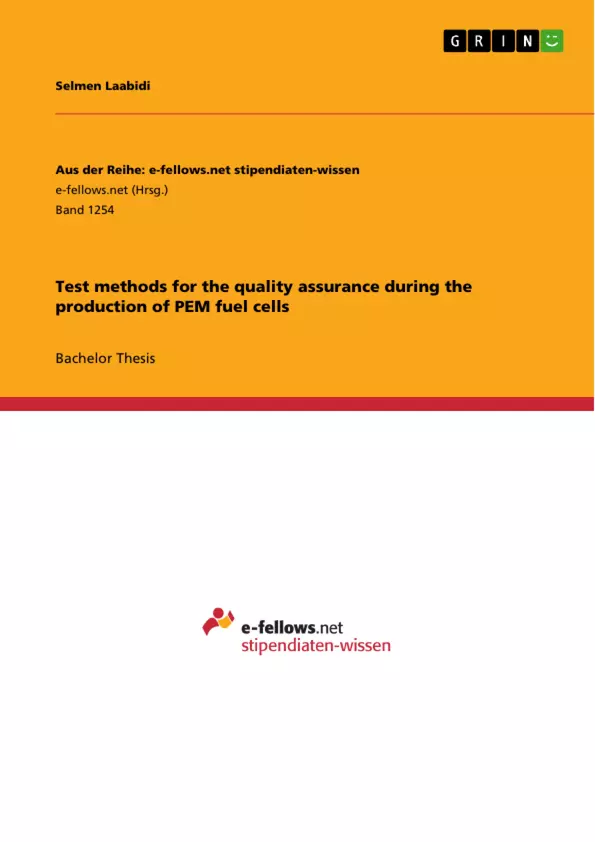With the rising cost of energy, the increasing environmental awareness and the global warming, alternative drive systems are becoming increasingly important. Here, the fuel cell technology makes as clean and reliable method of energy production a great contribution.
Many automotive companies like Hyundai, Daimler and Toyota are working intensively on fuel cell vehicles. Toyota has succeeded in December 2014 to bring the first car powered by hydrogen, the Toyota Mirai, on the market and it expects in the 2020s already with tens of thousands of vehicles annually.
Therefore, the sales numbers will be increasing, which will require a mass production of fuel cells.
Fuel cell technology is based on the principle of electrolysis. In order to generate electricity, hydrogen and oxygen are supplied to the fuel cell, where they react to electricity, water and heat. Thus cars powered by fuel cells have many advantages over cars with conventional sources, because they are environmentally friendly and save the long load time characterizing electric cars.
However, the current manufacturing way does not meet the requirements of mass production. To date, the components of the fuel cell are often assembled to a stack without sufficient testing, which significantly increases the potential for errors. After assembly, an end-of-line test is performed, wherein the fuel cell and its functions are checked up for up to 24 hours. To achieve higher production volume, the duration of the end-of-line tests must be reduced to a few minutes. This requires a total quality management and quality assurance during production in order to achieve a quick and error-free one. The aim of this work is to shorten the duration of the end-of-line test by the development of a montage accompanying control
plan.
The first part deals with the basics of the fuel cell technology. The most important historical events of the development of fuel cells are mentioned. In order to understand their functioning, the chemical and physical principles are explained and the functions of the individual components are described.
In the second part, a Failure mode and effect analysis (FMEA) is performed. Based on a literature review, this analysis aims at determining the most important errors in the components of the fuel cell. Its results deduce the most necessary test characteristics to be checked during the manufacturing of the fuel cell. [...]
Inhaltsverzeichnis (Table of Contents)
- Zusammenfassung
- Abstract
- 1 Einleitung
- 2 Grundlagen der Brennstoffzellentechnik
- 2.1 Historische Entwicklung der Brennstoffzelle
- 2.2 Funktionsweise der Brennstoffzelle
- 2.3 Aufbau einer Brennstoffzelle
- 3 Fehlermöglichkeits- und -einflussanalyse (FMEA)
- 3.1 Auswahl der Prüfmerkmale
- 3.2 Erstellung der FMEA Tabelle
- 4 Prüfmethoden
- 4.1 Prüfmethoden für die Membran
- 4.2 Prüfmethoden für die Elektroden
- 4.3 Prüfmethoden für den Stack
- 5 Messunsicherheiten
- 5.1 Einfluss der Messunsicherheiten auf die Fertigungstoleranzen
- 5.2 Auswahl der Messgeräte
- 6 Zusammenfassung und Ausblick
Zielsetzung und Themenschwerpunkte (Objectives and Key Themes)
This work aims to develop a comprehensive test plan for the quality assurance of PEM fuel cells during their production. The objective is to shorten the duration of the end-of-line test, which traditionally takes up to 24 hours, to a few minutes. This will facilitate mass production of fuel cells and enable the production of fuel cell vehicles on a larger scale.
- Fundamentals of Fuel Cell Technology
- Failure Mode and Effect Analysis (FMEA) for Fuel Cell Components
- Suitable Test Methods for Quality Assurance
- Measurement Uncertainties and their Impact on Manufacturing Tolerances
- Development of a Montage-Accompanying Test Plan
Zusammenfassung der Kapitel (Chapter Summaries)
- Chapter 1 provides a general introduction to the work, highlighting the importance of fuel cell technology and the need for efficient quality assurance during production.
- Chapter 2 delves into the fundamentals of fuel cell technology, covering the historical development, functioning, and components of fuel cells.
- Chapter 3 focuses on the Failure Mode and Effect Analysis (FMEA), which aims to identify potential failure modes in fuel cell components and their impact on the overall performance. This chapter also determines the necessary test characteristics to be evaluated during manufacturing.
- Chapter 4 presents a range of suitable test methods for the selected inspection characteristics. The choice of control methods considers the duration of the test and its suitability for mass production.
- Chapter 5 discusses measurement uncertainties and their impact on manufacturing tolerances. The chapter also explores the selection of appropriate measurement devices for the chosen test methods.
Schlüsselwörter (Keywords)
Fuel cell technology, PEM fuel cells, quality assurance, production, end-of-line test, FMEA, test methods, measurement uncertainties, manufacturing tolerances, mass production.
- Citar trabajo
- Selmen Laabidi (Autor), 2015, Test methods for the quality assurance during the production of PEM fuel cells, Múnich, GRIN Verlag, https://www.grin.com/document/299917



